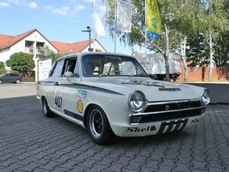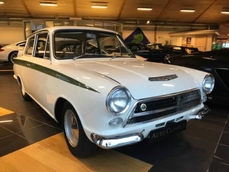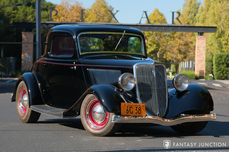Lotus Cortina MkI 1700 CC DOHC Inline 4 1965
General description :
1965 Lotus Cortina Shooting Brake Conversion
s/n 87E535210
Ermine White with Sherwood Green Flashes and Black Interior
The Lotus Cortina was developed under a unique and innovative partnership established with Ford UK and Lotus Cars. The collaboration began in 1963 using the Ford Cortina Mark 1 sedan. Colin Chapman and Ford had already established a great deal of progress in shared engine development for racing applications including work with Cosworth. Ford UK challenged Chapman to develop a twin cam engine specifically for 1000 Ford Saloons to achieve Group 2 homologation. Suspension modifications were extensive including shorter front struts, forged track control arms, and wider steel rims. The rear suspension was altered significantly with vertical coil springs and dampers along with trailing arms and stiffening braces. Additional mechanical features further enhanced the 1880 lb. Lotus Cortina making it a formidable player in rally and road racing events. Much like Shelby would do for the Mustang, the Lotus Cortina enticed a more youthful population to reconsider the formerly conservative Ford UK brand. Brisk sales resulted in 3,300 Mark 1 and over 4,000 Mark 2 models being produced.
Almost immediately the car earned stellar press reviews as enthusiasts who had previously considered a Mini Cooper or other sports cars moved to the more spacious and comfortable Lotus Cortina without sacrificing performance. The newly refined 1557 cc 105hp twin cam engine was both capable and durable, while the improved handling allowed for great cornering and spirited performance. All the cars were painted white with green side trim, front corner bumpers, and Lotus badges. Over the years, the Lotus Cortina has continued to garner ongoing enthusiast validation as more and more of these rare cars have been restored, fully sorted, and raced in numerous vintage events throughout the world.
In 2006, Lotus restoration expert and long time enthusiast Bob Herzog purchased a package of three cars, one of which was a solid Cortina Wagon. Herzog had already restored more than a dozen Lotus cars including a Lotus Cortina, Elans, and Europas, so he was confident that his vision to build a Lotus Cortina Wagon could be properly achieved. Herzog embarked on the build, documenting every aspect of the journey both online and in his personally authored self-published book:
a href="http://www.lotuscorps.org/pictures/index.php?/category/19" title="http://www.lotuscorps.org/pictures/index.php?/category/19">http://www.lotuscorps.org/pictures/index.php?/category/19/a>
a href="https://www.amazon.com/Lotus-Cortina-Shooting-Brake-ebook/dp/B00H7M5284/ref=sr_1_3?ie=UTF8&qid=1537153600&sr=8-3&keywords=bob+herzog" title="https://www.amazon.com/Lotus-Cortina-Shooting-Brake-ebook/dp/B00H7M5284/ref=sr_1_3?ie=UTF8&qid=1537153600&sr=8-3&keywords=bob+herzog">https://www.amazon.com/Lotus-Cortina-Shooting-Brake-ebook/dp/B00H7M5284/ref=sr_1_3?ie=UTF8&qid=1537153600&sr=8-3&keywords=bob+herzog/a>
Suffice it to say, the entire build was copiously documented and featured in multiple sources outlining the extensive detail and build process as Herzog focused on achieving the same goals Colin Champan was seeking when conceiving the sedans. Beginning with the engine, a 1.7 liter twin cam was sourced from a Caterham. The engine was built with slightly hotter cams, big valves, improved head flow, and finished with twin Weber carburetors and handmade headers, which were Jet-Hot coated. After extensive research and recommendations from Quantumechanics, a 5-speed Merkur gearbox was installed with an 8” T9 clutch using a specialized T9 adapter and T9 driveshaft yoke. Merkur rear disc brakes were also installed.
Mechanical modifications also included the suspension and chassis. All suspension components were carefully updated to reflect the best mechanical features available when the car was first developed. Lotus Cortina McPherson struts, thicker sway bar, short Lotus front springs, and Spax shocks with all new bushings were installed. Although Herzog was determined to make as correct a period car as possible, he allowed for important contemporary upgrades to make a more drivable and enjoyable car, including telescoping rear shocks, Pertronix ignition, a new gear reduction starter, 15 x 6 wheels, later model Recaro driver’s seat, and delightful wood cargo strips installed in the rear of the wagon. Other improvements include relocating the battery and included cut off switch to the rear storage compartment (just as the sedan models had done), braided stainless brake hoses, modern fittings and improved hardware.
The wagon body shell was sent to Stowe Auto Body in Joliet, IL, where it was completely stripped using soda blasting, tending to all areas including the engine bay, interior structure, and floors, with very little rust found, minor metal repairs were correctly welded before applying several coats of protective primer, paint and clear coat. The completed build established a wonderful precedent for Lotus enthusiasts and allowed Herzog to achieve his vision for the Lotus Cortina Shooting Brake that Chapman might very well have built. In 2014, shortly after completion, the car achieved a Best of Show award at the Chicago British Car Festival. Herzog sold the car to the current owner in 2016, a well-known California sports car enthusiast.
Today the car presents in superb, show-ready condition overall with glossy paint over very nice body surfaces, showing crisp and even paint lines separating the two tone colors. Currently 1,426 miles are indicated, and the car has been only lightly used over the past two years, showing virtually no evidence of road use. The chrome plated front corner bumpers are very nicely finished, while the rear stainless steel bumper is polished to a high luster. Grasping any of the beautifully re-chromed door handles, the doors open and shut smoothly and show very good panel fit with one rear door closing slightly proud of the rear fender surface. The hood and rear hatch open and shut smoothly with good fit, a generally strong indicator that the wagon structure has not been compromised. The lighting, glass, emblems, and trim are all in very nice condition, displaying good fit to the body and nice detailing. The wheels are nicely finished with chrome centers and lug nuts, accenting against the cast and polished surfaces. The tires showing very good tread remaining. Some of the impossibly rare and hard to find wagon rubber gaskets for the rear side glass and rear quarter windows are a bit dry, but don’t detract from the overall cleanliness of the car and the otherwise handsome detailing, chrome trim, and unique wagon details. Finishing off the exterior, yellow and green Lotus badges nicely accent the rear of the car.
The interior is handsomely restored with high quality materials, black carpeting showing only minimal wear, nicely fitting interior door panels, rear cargo side and hatch panels, fresh headliner, and matching white painted upper door trim. The formerly pedestrian utility of the wagon vanishes when viewing the dashboard, instruments, and leather wrapped steering wheel, all of which deliver that “just right” performance look to this very well appointed interior. The 1970s vintage Recaro seat gives the driver much needed high back and side support for more spirited driving. The rear bench seat is essentially like new with excellent finishes and trim. The cargo area is nicely finished with matching black vinyl side panels and chrome accents continued from the door panels. The floor of the cargo area has been detailed with beautifully finished oak planks, flanked by a custom made upholstered battery box and kill switch. Opening and closing the doors and rear hatch, the inner and underside painted surfaces display quality workmanship throughout and attention to detail that reflects the quality of the car’s build.
Under the hood, the Lotus twin cam engine displays the iconic blue twin cam head, carefully sourced and upgraded hardware, and mechanical refinement that further conveys the theme of this excellent build. Attention to detail continues throughout the engine compartment, down to the suspension, the tidiness of the electrical wiring (not only fully replaced but improved), polished or properly painted fittings, and beautifully finished white inner fenders and firewall. A pair of Weber carburetors adorns the passenger side of the cross flow head, while a tuned exhaust nicely finishes the driver’s side. The underside of the car is clean enough to eat off of and is further evidence of its comprehensive restoration, with matching white paint, excellent finishes, clean and tidy suspension components, and only minor signs of use since completion.
The car starts easily and idles smoothly with a pleasingly rorty exhaust note. Unlike the smaller sedan, the interior feels comfortable and quite roomy with all controls easily within reach, a comfortable seating position, and plenty of visibility. Clutch and shifter engage easily as a touch of the throttle sets the car in motion. The car tracks nicely, exhibiting composure and confidence as the driver moves through the gears. The gearbox is tight and quick-shifting, and the clutch pedal (assisted by an hydraulic Centerforce throwout bearing) is light and easily modulated. The tall first gear works great getting out of the hole with an overdrive 5th gear allowing smooth highway cruising. Brakes and steering are very good, giving a confidence-inspiring and chuckable feel to the car. The driving experience is captivating, combining utilitarian charm and spirited performance. A copy of the book “The Lotus Cortina Shooting Brake” by Bob Herzog and detailed receipts in a copious folder accompany the car along with itemized descriptions of parts and components used during construction.
This Lotus Cortina Shooting Brake conversion is a true one of a kind car that offers a visionary take on a car that very well might have been built in period. Ideally suited as a vintage racing support vehicle as well as a thrilling weekend driver or show car, this car’s specialized history, driving experience, and stunning restoration all contribute to making this a truly special car in both concept and construction.
http://fantasyjunction.com/cars/2160-Lotus-Cortina%20Shooting%20Brake-1700%20CC%20DOHC%20Inline%204
1965 Lotus Cortina MkI 1700 CC DOHC Inline 4 is listed sold on ClassicDigest in Emeryville by Fantasy Junction for $50000.
Car Facts
Car type : Car Make : Lotus Model : Cortina MkI Model Version : 1700 CC DOHC Inline 4 Engine size : 0.0 Model Year : 1965 Location : Emeryville
Sold
Seller Information
Sold
People who viewed this Lotus Cortina MkI also viewed similar Lotus listed at ClassicDigest
Other cars listed for sale by this dealer









